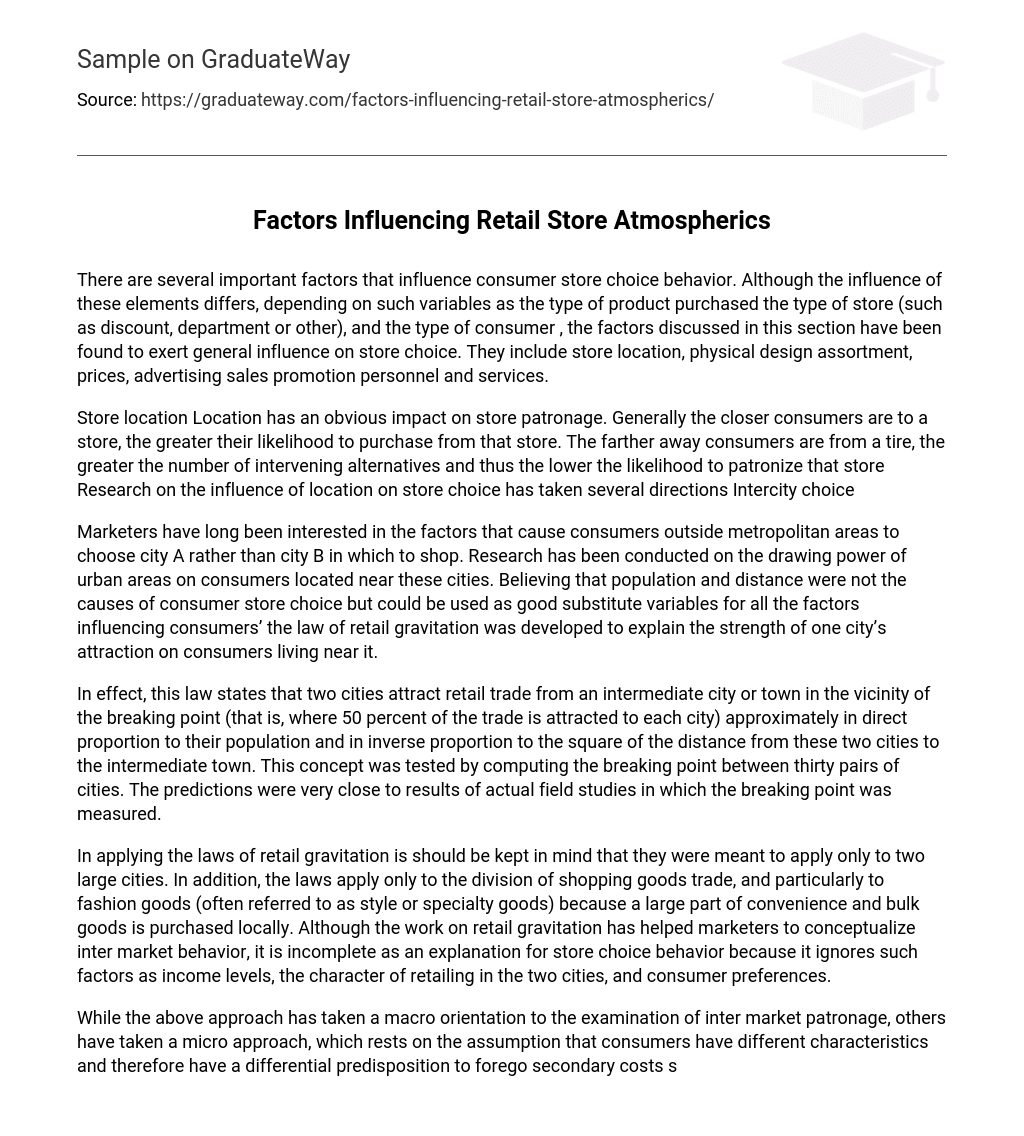Consumer store choice behavior is influenced by several factors. These factors depend on variables such as the product being purchased, the type of store (e.g. discount, department), and the type of consumer. However, the following factors generally affect store choice:
- Store location
- Physical design assortment
- Prices
- Advertising sales promotion personnel
- Services
The proximity of a store greatly influences the likelihood of consumers purchasing from that store. Research has extensively investigated how location affects consumer choices, particularly in intercity settings. When consumers are closer to a store, their chances of buying from it increase as they have fewer alternative options. Conversely, when consumers are farther away, they have more alternatives available and are less likely to patronize that specific store.
Research has been conducted on the factors that influence consumers outside metropolitan areas to choose shopping in city A instead of city B. Marketers are interested in understanding the drawing power of urban areas on consumers located near these cities. The law of retail gravitation was developed to explain the strength of one city’s attraction on consumers living nearby, using population and distance as substitute variables for all the influencing factors.
In simple terms, this law explains that two cities will attract retail trade from a nearby intermediate town based on the population of the cities and the distance between them and the town. This concept was verified by determining the breaking point between thirty pairs of cities, and the predictions were found to be very similar to the actual field study results.
The application of the laws of retail gravitation should be considered with the understanding that they were originally intended for use in two major cities. Furthermore, these laws specifically pertain to the division of trading in shopping goods, specifically fashion goods which are often known as style or specialty goods. This is due to the fact that convenience and bulk goods are typically purchased locally. While the study of retail gravitation has assisted marketers in understanding inter-market behavior, it fails to fully explain store selection behavior as it disregards factors such as income levels, the nature of retailing in both cities, and consumer preferences.
Both macro and micro approaches have been taken to examine inter-market patronage. The macro approach focuses on overall trends, while the micro approach looks at individual consumer characteristics that may influence their decision to shop in one trade area over another. Studies have found that some consumers, known as “out shoppers,” often shop outside of their local area and can be identified by specific demographic and psychographic traits. This analysis also applies to intracity choice.
Since 1950, as shopping centers emerged, researchers have been studying how they impact consumer shopping behavior. These suburban alternatives to downtown shopping districts have brought new insights into explaining store preferences. In urban areas, studies have investigated the role of driving distance in influencing shopping center choice. It seems that travel times exceeding fifteen minutes discourage many shoppers from choosing a shopping center. However, those willing to drive for longer durations are often attracted to larger shopping centers.
Another study suggests that the location of a shopping center is not as crucial as other factors, including price value, product variety, store quality and cleanliness, and friendly sales personnel. This finding contradicts the focus on distance measures in typical site location models.
Several economic factors influence retail sales and can have either a positive or negative effect on businesses. The condition of the economy determines the impact of these economic factors on retail companies. The economy constantly encounters factors that can cause growth or decline, consequently affecting everyone.
Technology is increasingly important in the retail industry, with many consumers and businesses choosing to shop online. Retailers who have not embraced this trend are experiencing lower sales and financial difficulties. However, large retail stores understand the benefits of offering online availability, providing convenience for busy customers and eliminating the need for in-store marketing campaigns. Many retail outlets offer discount coupons or promotional codes on select merchandise, resulting in increased sales.
The growth of population and tourism also significantly impacts retail sales. The size of the population, particularly newborns versus baby boomers, determines the extent of retail sales. Currently, baby boomers nearing retirement age are unable to spend as much. Additionally, there is a high number of dependents under 14 and over 65 years old. The middle-aged population caring for these dependents has less disposable income which negatively affects retail sales. Nonetheless, certain communities can create economic opportunities.
Concerts, festivals, and large sporting events act as tourist attractions, generating additional revenue for the area and boosting retail sales. The income earned by businesses during these events enables them to sustain themselves during slower periods. Advertising tactics are crucial in the retail sector, with campaigns aimed at promoting sales or new products. In times of economic difficulty, not all companies can afford a dedicated marketing department. As a result, smaller retail firms face more challenges, striving to stay afloat despite experiencing increased sales.





